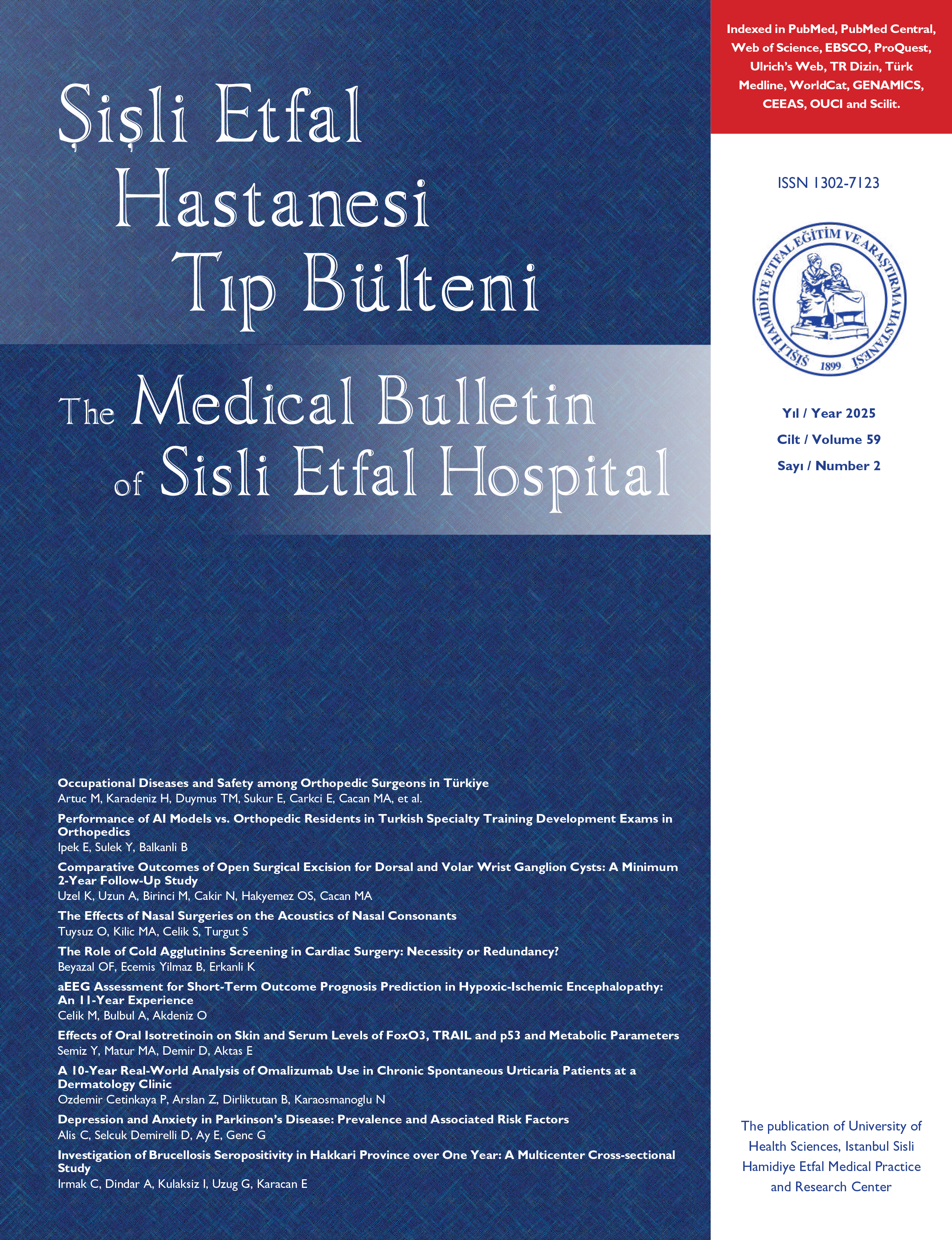
Choroidal Thickness in Mild Autonomous Cortisol Secretion
Sezin Dogan Cakir1, Akin Cakir2, Feyza Yener Ozturk3, Seda Erem Basmaz4, Adnan Batman5, Emre Sedar Saygili6, Rumeysa Selvinaz Erol3, Esra Cil Sen3, Muhammed Masum Canat3, Yuksel Altuntas31Division of Endocrinology and Metabolism, Department of Internal Medicine, University of Health Sciences Türkiye, Prof. Dr. Cemil Tascioglu City Hospital, Istanbul, Türkiye2Department of Ophthalmology, University of Health Sciences Türkiye, Prof. Dr. Cemil Tascioglu City Hospital, Istanbul, Türkiye
3Division of Endocrinology and Metabolism, Department of Internal Medicine, University of Health Sciences Türkiye, Sisli Hamidiye Etfal Training and Research Hospital, Istanbul, Türkiye
4Division of Endocrinology and Metabolism, Department of Internal Medicine, Derince Training and Research Hospital, Kocaeli, Türkiye
5Division of Endocrinology and Metabolism, Department of Internal Medicine, Koc University Faculty of Medicine, Istanbul, Türkiye
6Division of Endocrinology and Metabolism, Department of Internal Medicine, Canakkale Onsekiz Mart University Faculty of Medicine, Canakkale, Türkiye
Objectives: To evaluate the patients with mild autonomous cortisol secretion (MACS) by means of choroidal thickness (CT) and also investigate whether CT may be a diagnostic tool in the management of MACS or not.
Methods: Twenty-seven patients with MACS and 25 age-sex-matched healthy controls were enrolled in this cross-sectional comparative study. All the participants underwent CT measurement by using Spectralis optical coherence tomography (Heidelberg Engineering, Heidelberg, Germany) with enhanced deep imaging mode at the subfoveal, 500-1000-1500 μm nasal and 500-1000- 1500 μm temporal to the foveola.
Results: The groups were similar in terms of spherical equivalence, age and axial lengths. The mean CT was significantly thicker in patients with MACS than controls in all measurement quadrants (p<0.001). There was no significant correlation between CT, size of the adenoma, basal cortisol, 1mg dexamethasone suppression test, salivary cortisol, 24-hour total urine-free cortisol, ACTH and DHEAS levels. However, 2 mg dexamethasone suppression test results were found to be significantly correlated with CT in temporal 500-1000 and 1500 μm quadrants (r=0.436, p=0.023, r=0.443, p=0.021 and r=0.488, p=0.010, respectively). Five (18.5%) eyes had pachychoroid pigment epitheliopathy in the MACS group.
Conclusion: CT increases in patients with MACS and those tend to have pachychoroid pigment epitheliopathy more frequent than healthy individuals. A thicker choroid in the patients with MACS may be a novel biomarker both as a diagnostic tool for the degree of hypercortisolemia and cortisol-related comorbidity.
Ilımlı Otonom Kortizol Sekresyonunda Koroid Kalınlığı
Sezin Dogan Cakir1, Akin Cakir2, Feyza Yener Ozturk3, Seda Erem Basmaz4, Adnan Batman5, Emre Sedar Saygili6, Rumeysa Selvinaz Erol3, Esra Cil Sen3, Muhammed Masum Canat3, Yuksel Altuntas31Türkiye Sağlık Bilimleri Üniversitesi, Prof. Dr. Cemil Taşçıoğlu Şehir Hastanesi, İç Hastalıkları-Endokrinoloji ve Metabolizma Kliniği, İstanbul2Türkiye Sağlık Bilimleri Üniversitesi, Prof. Dr. Cemil Taşçıoğlu Şehir Hastanesi, Göz Hastalıkları Kliniği, İstanbul
3Türkiye Sağlık Bilimleri Üniversitesi, Şişli Hamidiye Etfal Eğitim ve Araştırma Hastanesi, İç Hastalıkları-Endokrinoloji ve Metabolizma Kliniği, İstanbul
4Derince Eğitim ve Araştırma Hastanesi, İç Hastalıkları-Endokrinoloji ve Metabolizma Kliniği, Kocaeli
5Koç Üniversitesi Tıp Fakültesi, İç Hastalıkları Anabilim Dalı, Endokrinoloji ve Metabolizma Bilim Dalı, İstanbul
6Çanakkale Onsekiz Mart Üniversitesi Tıp Fakültesi, İç Hastalıkları Anabilim Dalı, Endokrinoloji ve Metabolizma Bilim Dalı, Çanakkale
Amaç: Ilımlı Otonom Kortizol Sekresyonu (IOKS) olan hastaları koroid kalınlığı (KK) açısından değerlendirmek ve KK'nın IOKS yönetiminde bir tanı aracı olup olamayacağını araştırmak.
Yöntem: Bu kesitsel karşılaştırmalı çalışmaya IOKS saptanan 27 hasta ile yaş ve cinsiyet açısından uyumlu 25 sağlıklı kontrol grubu olarak dahil edildi. Tüm katılımcılara Spektralis Optik Koherens Tomografi (Heidelberg Engineering, Heidelberg, Almanya) cihazı kullanılarak subfoveal, 500-1000-1500 µm nazal ve 500-1000-1500 µm temporal foveolada geliştirilmiş derin görüntüleme modu kullanılarak KK ölçümü yapıldı.
Bulgular: Gruplar sferik ekivalan, yaş ve aksiyal uzunluklar açısından benzerdi. Ortalama KK, tüm ölçüm kadranlarında IOKS hastalarında kontrollere göre anlamlı derecede daha kalındı (p<0.001). Koroid kalınlığı ile adenom büyüklüğü, 1mg deksametazon supresyon testi, tükrük kortizolü, 24 saat idrar serbest kortizolü, bazal kortizol, ACTH ve DHEAS düzeyleri arasında anlamlı bir ilişki saptanmadı. Ancak 2 mg deksametazon supresyon testi sonuçlarının temporal 500-1000 ve 1500 µm kadranlarda KK ile anlamlı düzeyde ilişkili olduğu görüldü (r=0.436, p=0.023; r=0.443, p=0.021 ve r=0.488, p=0.010; sırasıyla). IOKS grunuda 5 (%18.5) hastada pakikoroid pigment epitelyopati izlendi.
Sonuç: Ilımlı Otonom Kortizol Sekresyonu olan hastalarda, KK ve pakikoroid pigment epitelyopati sıklığı artmaktadır. Ilımlı Otonom Kortizol Sekresyonu olan hastalarda daha kalın koroid, hem hiperkortizoleminin derecesi hem de hiperkortizolemi ilişkili komorbidite varlığı için tanısal bir araç olarak yeni bir biyobelirteç olabilir. (SETB-2023-11-206)
Manuscript Language: English



















